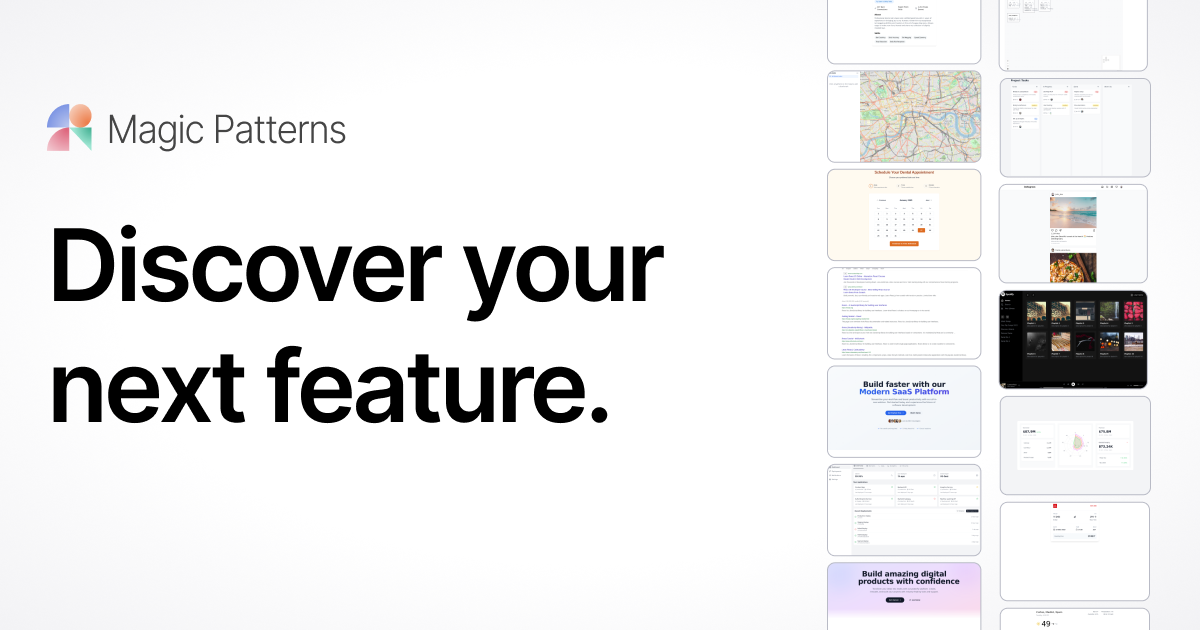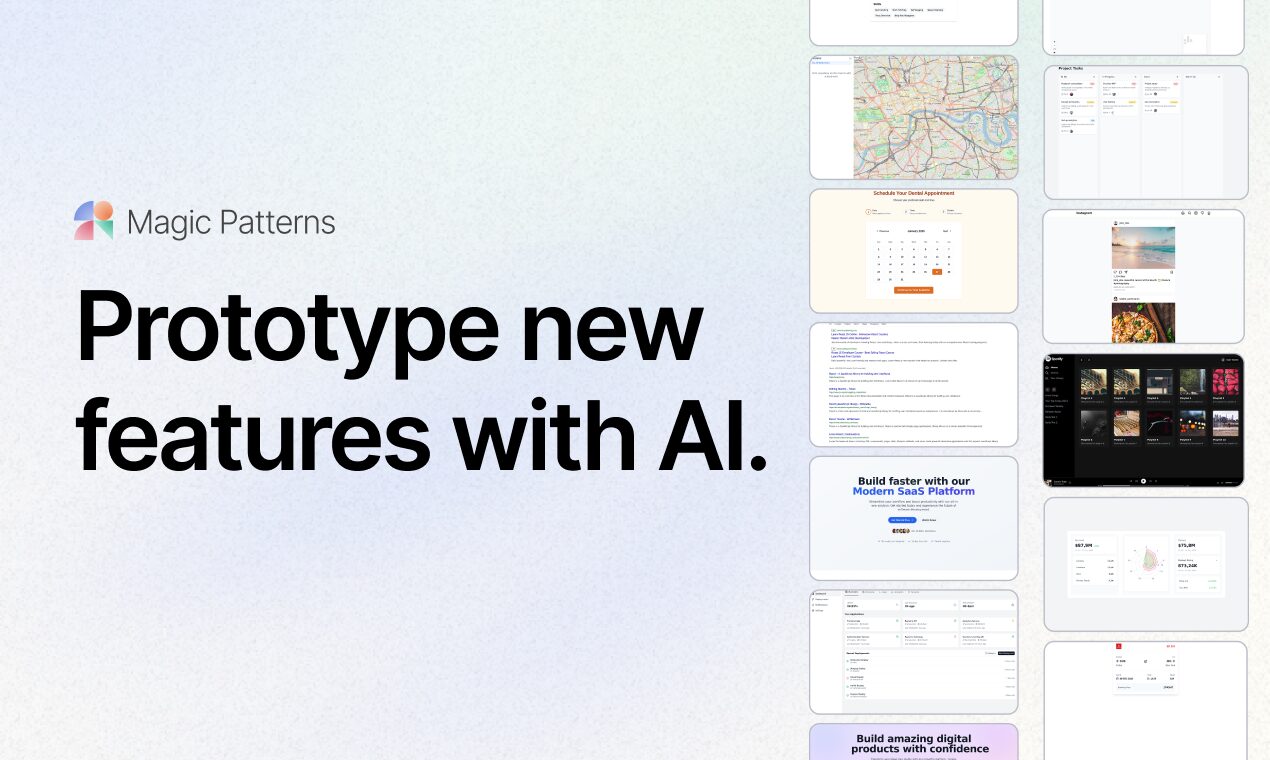
Table of Contents
Overview
Magic Patterns represents a pioneering AI-powered prototyping platform that enables product teams to rapidly create interactive designs, collect user feedback, and make data-driven decisions with unprecedented efficiency. Launched as a Y Combinator-backed company, this platform has gained significant traction with over 1 million designs created by its community and adoption by both Fortune 500 companies and early-stage startups. Magic Patterns distinguishes itself by combining visual design capabilities with code generation, allowing users to transform text prompts or uploaded images into functional UI components while maintaining the flexibility to export clean, production-ready code in React, Vue, and Tailwind CSS formats.
The platform operates on a collaborative infinite canvas model similar to modern design tools, enabling real-time multiplayer editing and seamless integration with existing design workflows. With its Chrome extension for design inspiration and built-in component library system, Magic Patterns addresses the growing need for rapid prototyping solutions that bridge the gap between design and development while maintaining professional quality standards.
Key Features
Magic Patterns incorporates several innovative capabilities designed to accelerate the product development process:
- AI-driven text-to-UI generation: Transform natural language descriptions or user stories into interactive UI components within seconds, utilizing advanced AI algorithms to interpret design requirements and generate layouts that match existing design systems or preset styling frameworks.
- **Real infinite design canvas that supports multiplayer editing, version control, and contextual commenting, enabling seamless collaboration between designers, developers, and product managers throughout the prototyping process.
- Code-based mockup creation: Generate designs using actual HTML, CSS, and JavaScript code rather than static images, ensuring that prototypes closely match final implementation while providing developers with production-ready code that requires minimal cleanup or translation.
- Design system integration: Import and utilize existing design systems, brand guidelines, and component libraries to ensure consistency across generated designs, with support for custom styling presets and reusable component creation for maintaining brand coherence.
- Chrome extension for design inspiration: Capture and reference UI elements from live websites or local builds through a browser extension that allows users to extract HTML and CSS from existing interfaces, adapt design ideas, and incorporate them into new projects with proper attribution.
- Multi-format export capabilities: Export designs to various formats including production-ready React, Vue, and Tailwind CSS code, Figma-compatible files through dedicated plugins, or standalone HTML/CSS packages for immediate deployment or further development.
How It Works
Magic Patterns operates through an intuitive workflow that combines AI-powered generation with traditional design principles. Users begin by creating a new project within the platform’s web-based interface or through the desktop application. The primary interaction method involves entering text prompts that describe desired UI components, layouts, or entire application screens, which the AI then interprets to generate corresponding visual designs.
These prompts can range from simple requests like “create a login form” to complex specifications such as “design a dashboard with analytics charts and user management controls.” The platform’s AI engine analyzes these requests and produces interactive designs that can be immediately previewed and tested. Users can iteratively refine generated designs through additional prompts or direct manipulation using familiar design tools.
The infinite canvas allows for organizing multiple design variations, connecting different screens into user flows, and collaborating with team members in real-time. Integration with existing design systems enables the AI to generate components that match established brand guidelines, while the Chrome extension facilitates inspiration gathering from existing websites by extracting and adapting UI elements for new projects.
Use Cases
Magic Patterns serves diverse product development scenarios across various organizational contexts:
- Rapid concept validation and ideation: Enable product teams to quickly transform ideas into testable prototypes for stakeholder presentations, user research sessions, and concept validation studies, reducing the time from initial concept to feedback collection from weeks to hours.
- Cross-functional team collaboration: Bridge communication gaps between product managers, designers, and developers by creating visual representations of requirements that all team members can understand, iterate upon, and reference throughout the development process.
- User experience testing and research: Generate multiple design variations for A/B testing scenarios, usability studies, and user interview sessions, with built-in analytics integration to track user interactions and gather quantitative feedback on design performance.
- Client presentation and demo creation: Develop interactive prototypes for client presentations, sales demonstrations, and stakeholder reviews that accurately represent proposed solutions while maintaining professional visual standards and brand consistency.
- Design system development and maintenance: Create and iterate on design system components, establish visual consistency across products, and generate documentation for development teams through automated code export and component library features.
- Educational and training applications: Support design education and team training by providing accessible tools for learning UI/UX principles, rapid prototyping techniques, and collaborative design workflows without requiring extensive technical expertise.
Pros \& Cons
Magic Patterns presents several advantages while also facing certain limitations that teams should carefully evaluate:
Advantages
- Exceptional speed in prototype creation: The AI-powered text-to-UI generation dramatically reduces the time required to create functional prototypes, enabling rapid iteration cycles and faster validation of design concepts compared to traditional design workflows that require manual component creation.
- Production-ready code generation: Unlike many prototyping tools that produce static mockups, Magic Patterns generates clean, maintainable code in popular frameworks, significantly reducing the gap between design and development while ensuring prototypes can evolve into production applications.
- Collaborative workflow optimization: The real-time multiplayer canvas and integrated commenting system facilitate seamless collaboration between different disciplines, reducing communication overhead and ensuring all team members can contribute meaningfully to the design process.
- Design system consistency enforcement: Built-in support for design systems and component libraries ensures that generated designs maintain brand consistency and follow established guidelines, reducing the risk of design drift and improving overall product coherence.
- Accessibility for non-technical users: The natural language interface and intuitive design tools make advanced prototyping capabilities accessible to product managers, marketers, and other team members who may lack traditional design or development skills.
Disadvantages
- AI generation limitations and unpredictability: While powerful, AI-generated designs may not always perfectly interpret complex or nuanced requirements, potentially requiring significant manual refinement for sophisticated user interfaces or specialized use cases.
- Learning curve for advanced features: Despite its user-friendly interface, mastering Magic Patterns’ full feature set, including component library management, advanced animation capabilities, and code customization options, requires substantial time investment.
- Platform dependency concerns: As a relatively new platform, teams may have concerns about long-term viability, data portability, and vendor lock-in, particularly for critical projects that require extended support and maintenance cycles.
- Limited offline functionality: The cloud-based nature of the platform requires consistent internet connectivity for optimal performance, which may restrict usage in environments with unreliable network access or strict security requirements.
How Does It Compare?
Magic Patterns operates within a competitive landscape of design and prototyping tools, each serving different aspects of the product development workflow.
Figma remains the dominant collaborative design platform with comprehensive vector design capabilities, advanced prototyping features, and extensive plugin ecosystems, but focuses primarily on traditional design workflows rather than AI-powered generation, making it more suitable for detailed design work but less efficient for rapid concept exploration.
Adobe XD offers robust prototyping capabilities with voice design features, timeline-based animations, and strong integration with the Adobe Creative Suite, though it lacks the AI-driven generation capabilities that make Magic Patterns distinctive and has faced reduced development investment from Adobe in recent years.
Framer provides powerful interactive design capabilities with code components and advanced animation tools, positioning it as a bridge between design and development, but requires more technical expertise and lacks the natural language interface that makes Magic Patterns accessible to non-technical users.
InVision Studio specializes in high-fidelity prototyping with sophisticated animation capabilities and collaborative workflow features, though its development has slowed significantly and it lacks the modern AI-powered features that contemporary tools provide.
Maze excels in user testing and feedback collection with comprehensive analytics and participant management features, but operates primarily as a testing platform rather than a design creation tool, making it complementary rather than competitive to Magic Patterns.
Proto.io offers no-code prototyping with extensive interaction libraries and device-specific testing capabilities, but focuses on traditional drag-and-drop interfaces rather than AI-powered generation.
UXPin provides design systems management with code-based components and advanced prototyping features, though it targets more enterprise-focused workflows and lacks the rapid generation capabilities that define Magic Patterns.
Webflow enables visual web development with CMS capabilities and e-commerce features, making it suitable for complete website creation but less focused on the iterative prototyping and feedback collection workflows that Magic Patterns optimizes.
Magic Patterns’ unique positioning combines the accessibility of natural language interfaces with the power of code generation, creating a distinctive niche in rapid prototyping for product teams who need to quickly validate concepts while maintaining development-ready output quality.
Final Thoughts
Magic Patterns represents a compelling evolution in prototyping tools by successfully combining artificial intelligence with traditional design principles to create an accessible yet powerful platform for product development teams. The platform’s ability to transform natural language descriptions into functional, code-based prototypes addresses a genuine market need for faster iteration cycles and improved collaboration between technical and non-technical team members.
While the AI-driven approach offers significant advantages in speed and accessibility, teams should carefully consider their specific requirements regarding design complexity, customization needs, and long-term platform dependencies. The platform’s strength lies in its ability to democratize advanced prototyping capabilities while maintaining professional output quality, making it particularly valuable for organizations seeking to accelerate their product validation processes.
As the platform continues to mature and expand its feature set, Magic Patterns has the potential to establish itself as an essential tool in the modern product development stack, particularly for teams that prioritize rapid experimentation and cross-functional collaboration. However, organizations with highly specialized design requirements or those requiring extensive offline functionality may find traditional design tools better suited to their needs.
The platform’s success will ultimately depend on its ability to balance AI-powered automation with the flexibility and control that experienced designers require for sophisticated product development workflows.

